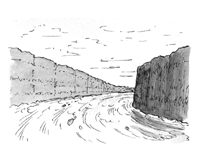
|
|
Mystery of the Megaflood
|

|
|
Program Overview
|

|
 NOVA presents the story of the greatest flood ever found in the
geologic record and the geologist who went against prevailing
theories to explain that the flood had occurred.
NOVA presents the story of the greatest flood ever found in the
geologic record and the geologist who went against prevailing
theories to explain that the flood had occurred.
The program:
-
reviews geologist J Harlen Bretz's radical theory—first
proposed in 1923—that a massive flood formed some of the
Pacific Northwest's unusual geologic features.
-
presents the evidence collected by Bretz during his research,
including the existence of the Channeled Scabland and the dry
waterfalls, potholes, and erratics within the scablands.
-
explains that, at the time, most scientists believed the
Northwest's geological features were created through gradual
erosive processes; the scientists followed the theory of
uniformitarianism, which ruled out sudden catastrophic creations
of landscapes.
-
recounts the difficulty faced by Bretz as he worked to convince
the scientific community of his theory.
-
reports the key role of Joseph Thomas Pardee, the geologist who
found evidence for an enormous body of glacial meltwater that
could have provided the flood's source of water.
-
describes how Pardee theorized that a lobe of the Cordilleran
ice sheet dammed the Clark Fork River, forming an ice barrier
that eventually walled off a lake described in size as "an
inland sea."
-
recreates what might have happened when the lake's water
eventually breached the ice dam, allowing Glacial Lake Missoula
to flood westward.
-
reveals evidence indicating that the flood Bretz theorized may
have been only one of many that repeatedly swept through the
region.
Taping Rights: Can be used up to one year after the program
is taped off the air.
|

|
